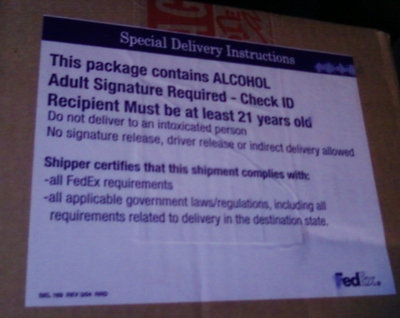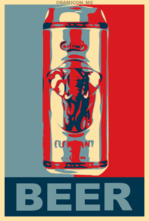Sleeping peacefully this morning, I was awakened by the sound of a Fed Ex van navigating the washed out riverbed that pretends to be my driveway. Barely concious, I managed to sign for a large package, with an Ominous and Foreboding sticker on the front:

Opening the package carefully, so as to not break anything, I discovered 3 bottles of Papagayo Spiced Organic Rum, resting safely in their individual cardboard nests. Pulling one out, I admired the sleekness of the bottle and the well done packaging for some time.
My reverie was broken by an urgent message from my body, "YOU SIR, MUST HAVE TEA". So with a shout of "Chai Wallah, My Tea!" I sat down and rolled myself a hand crafted cigarette of the finest calibre and began the complicated process of waiting for my tea. Perusing my standard morning entertainment and sipping the almost (but not quite) perfectly brewed cup of Frontier Fair Trade Earl Grey which had been delivered quickly and professionally, I thought about the rum I would be sipping later this evening.
Rum is nothing more than fermented and distilled sugar cane, right? How can one rum be better than another? I now had a daunting task, one that would haunt me for hours: find out what makes different rums different
The first thing that makes rums different, as can be expected, is materials. Some rums start with already processed, sugar cane products such as molasses and sugar cane juice. Some rums start with the whole cane, and crush it to syrup right into the fermentation vessels. Papagayo is of the latter type (and as a bonus, uses organic sugar cane), and I think it shows in the full but not overpowering sweetness of the sip.
The main difference in the distillation process seems to be traditional, or "pot" stills, versus column stills (which, while allowing for higher output, don't retain some of the nicer flavours from the fermented syrup) . With batch processed rum, such as Papagayo, using the traditional stills imparts a fuller flavour to the rum.
Finally, ageing is also an issue, and there are no hard and fast rules here, everyone ages in different types of casks, for different times. In fact, different types of rum are aged in different types of casks, oak casks for dark rum, steel (or other man made materials) for the lighter rums.
Having consumed several glasses, I can tell you it is quite consistent. A low scent of combined spice in the nose, very unobtrusively alcoholic, followed by the clove mellowed bite of the alcohol as I take my sip. the fire of the clove bite fades quickly to vanilla.
As my day winds down, I can see that an night smoke and another glass or two is in order. This is an excellent rum, the spicing and sweetness are just right. At $25-35 a bottle, this isn't a rum for ruining with water. Sip it neat, and say Arrrr Matey!
Until next time,
--Christopher

Opening the package carefully, so as to not break anything, I discovered 3 bottles of Papagayo Spiced Organic Rum, resting safely in their individual cardboard nests. Pulling one out, I admired the sleekness of the bottle and the well done packaging for some time.
My reverie was broken by an urgent message from my body, "YOU SIR, MUST HAVE TEA". So with a shout of "Chai Wallah, My Tea!" I sat down and rolled myself a hand crafted cigarette of the finest calibre and began the complicated process of waiting for my tea. Perusing my standard morning entertainment and sipping the almost (but not quite) perfectly brewed cup of Frontier Fair Trade Earl Grey which had been delivered quickly and professionally, I thought about the rum I would be sipping later this evening.
Rum is nothing more than fermented and distilled sugar cane, right? How can one rum be better than another? I now had a daunting task, one that would haunt me for hours: find out what makes different rums different
The first thing that makes rums different, as can be expected, is materials. Some rums start with already processed, sugar cane products such as molasses and sugar cane juice. Some rums start with the whole cane, and crush it to syrup right into the fermentation vessels. Papagayo is of the latter type (and as a bonus, uses organic sugar cane), and I think it shows in the full but not overpowering sweetness of the sip.
The main difference in the distillation process seems to be traditional, or "pot" stills, versus column stills (which, while allowing for higher output, don't retain some of the nicer flavours from the fermented syrup) . With batch processed rum, such as Papagayo, using the traditional stills imparts a fuller flavour to the rum.
Finally, ageing is also an issue, and there are no hard and fast rules here, everyone ages in different types of casks, for different times. In fact, different types of rum are aged in different types of casks, oak casks for dark rum, steel (or other man made materials) for the lighter rums.
Having consumed several glasses, I can tell you it is quite consistent. A low scent of combined spice in the nose, very unobtrusively alcoholic, followed by the clove mellowed bite of the alcohol as I take my sip. the fire of the clove bite fades quickly to vanilla.
As my day winds down, I can see that an night smoke and another glass or two is in order. This is an excellent rum, the spicing and sweetness are just right. At $25-35 a bottle, this isn't a rum for ruining with water. Sip it neat, and say Arrrr Matey!
Until next time,
--Christopher

 By
By 









 By
By 





